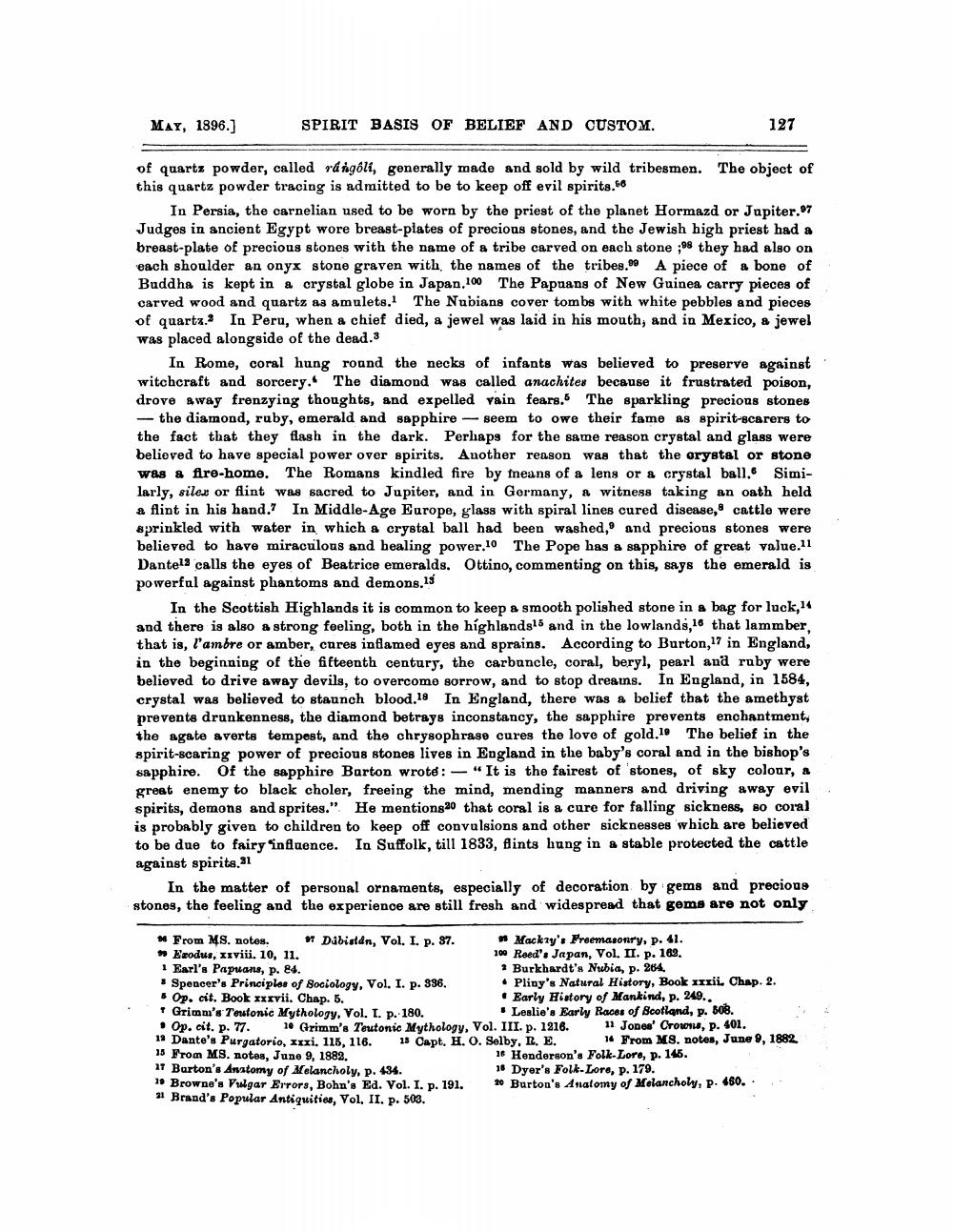________________
MAY, 1896.]
SPIRIT BASIS OF BELIEF AND CUSTOM.
127
of quartz powder, called rangoli, generally made and sold by wild tribesmen. The object of this quartz powder tracing is admitted to be to keep off evil spirits.66
In Persia, the carnelian used to be worn by the priest of the planet Hormazd or Japiter. 7 Judges in ancient Egypt wore breast-plates of precious stones, and the Jewish high priest had a breast-plate of precious stones with the name of a tribe carved on each stone ;98 they had also on each shoulder an onyx stone graven with the names of the tribes. A piece of a bone of Buddha is kept in a crystal globe in Japan.100 The Papuans of New Guinea carry pieces of carved wood and quartz aa amulets. The Nubians cover tombs with white pebbles and pieces of quartz. In Peru, when a chief died, a jewel was laid in his mouth, and in Mexico, a jewel was placed alongside of the dead.3
In Rome, coral hung round the necks of infants was believed to preserve against witchcraft and sorcery. The diamond was called anachites because it frustrated poison, drove away frenzying thoughts, and expelled yain fears. The sparkling precious stones
- the diamond, ruby, emerald and sapphire - seem to owe their fame as spirit-scarers to the fact that they flash in the dark. Perhaps for the same reason crystal and glass were believed to have special power over spirits. Another reason was that the crystal or stone Was & fire-home. The Romans kindled fire by ineans of a lens or & crystal ball. Similarly, silex or flint was sacred to Jupiter, and in Germany, a witness taking an oath held a flint in his hand. In Middle-Age Europe, glass with spiral lines cured disease, e cattle were sprinkled with water in which a crystal ball had been washed, and precious stones were believed to have miraculous and healing power.10 The Pope has a sapphire of great value.11 Dantels calls the eyes of Beatrice emeralds. Ottino, commenting on this, says the emerald is powerful against phantoms and demons.is
In the Scottish Highlands it is common to keep a smooth polished stone in a bag for luck, 14 and there is also a strong feeling, both in the highlands and in the lowlands, 16 that lammber, that is, l'ambre or amber, cares inflamed eyes and sprains. According to Burton,17 in England, in the beginning of the fifteenth century, the carbuncle, coral, beryl, pearl and ruby were believed to drive away devils, to overcome sorrow, and to stop dreains. In England, in 1584, crystal was believed to staunch blood.18 In England, there was a belief that the amethyst prevents drunkenness, the diamond betrays inconstancy, the sapphire prevents enchantment, the agate averts tempest, and the chrysophrase cures the love of gold.l. The belief in the spirit-scaring power of precious stones lives in England in the baby's coral and in the bishop's sapphire. Of the sapphire Barton wrote: - " It is the fairest of stones, of sky colour, & great enemy to black choler, freeing the mind, mending manners and driving away evil spirits, demons and sprites.". He mentions20 that coral is a cure for falling sickness, so coral is probably given to children to keep off convulsions and other sicknesses which are believed to be due to fairy 'influence. In Suffolk, till 1833, Aints hung in a stable protected the cattle against spirits.21
In the matter of personal ornaments, especially of decoration by gems and precious stones, the feeling and the experience are still fresh and widespread that gems are not only
# From MS. notes. 97 Dibistan, Vol. I. p. 37.
Mackzy's Freemasonry, p. 41. » Exodus, xxviii. 10, 11.
100 Reed'. Japan, Vol. II. p. 189. 1 Earl's Papuans, p. 84.
- Burkhardt's Nubia, p. 264. * Spencer's Principles of Sociology, Vol. I. p. 396. • Pliny's Natural History, Book xxxii. Chap. 2. • Op. cit. Book xxxvii. Chap. 5.
• Early History of Mankind, p. 249.. + Grimm's Teutonic Mythology, Vol. I. p. 180.
Leslie's Early Races of Scotland, p. 608. • Op. cit. p. 77. 20 Grimm's Teutonic Mythology, Vol. III. p. 1916. 11 Jones' Crown, P. 401. 11 Dante's Purgatorio, xxxi, 115, 116. 15 Capt. H. O. Selby, L, E.
From M8. notes, June 9, 1882 15 From MS. notes, June 9, 1882.
16 Henderson's Folk-Lore, p. 145. 17 Barton's Anatomy of Melancholy, p. 434.
18 Dyer's Folk-Lore, p. 179. 1. Browne's Vulgar Errors, Bohn's Ed. Vol. I. p. 191. 70 Burton's Anatomy of Melancholy, P. 460.. 21 Brand's Popular Antiquities, Vol. II. p. 503.




